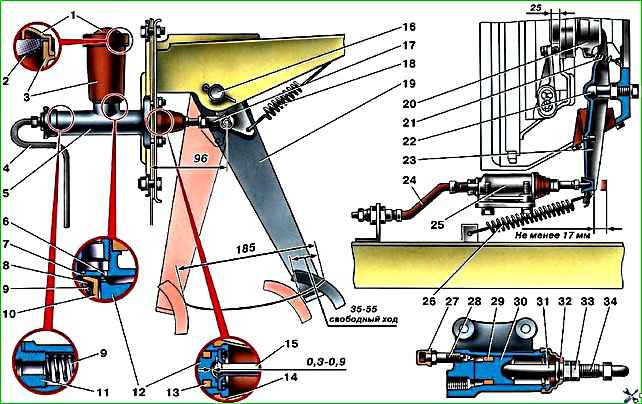Fill the hydraulic drive with fluid and pump it to remove air in the following order:
- – lift the hood on cars of the UAZ-31512 family or remove the cover 13 of the hatch to the hydraulic clutch reservoir on the instrument panel of cars of the UAZ-3741 family and unscrew the cover of the master cylinder reservoir;

- – fill the master cylinder reservoir with working fluid to the normal level (15–20 mm below the top edge of the reservoir);
- – remove the protective cap from the head of the working cylinder bleeding valve and place a rubber hose on the head;
- – immerse the free end of the hose into a vessel with a capacity of at least 0.5 liters, filled halfway with working fluid;
- – create pressure in the system by sharply pressing the clutch pedal 4–5 times at intervals of 1–2 s;
- – while holding the pedal, unscrew the bleeder valve ½–¾ of a turn, making sure that the free end of the hose remains immersed in the liquid.
Liquid with air bubbles will enter the vessel;
- – after the flow of liquid into the vessel stops, close the bypass valve as far as it will go with the clutch pedal pressed;
- – check the presence of fluid in the master cylinder reservoir. Do not allow the bottom of the tank to be exposed while pumping, otherwise air will enter the system again;
- – repeat the above operations until liquid and air stop flowing from the hose;
- – remove the hose from the bypass valve head and put on the protective cap;
- – add fluid to the tank to the required level.
You cannot add liquid released during bleeding into the tank, as it contains air.
This liquid can be used only after it has been allowed to settle for 24 hours and filtered.
After bleeding, check the amount of travel of the outer end of the clutch release fork when pressing the clutch release pedal all the way.
The full stroke must be at least 17 mm.
A smaller full stroke will not ensure complete disengagement of the clutch and will indicate the presence of air in the hydraulic drive or insufficient travel of the clutch pedal.





